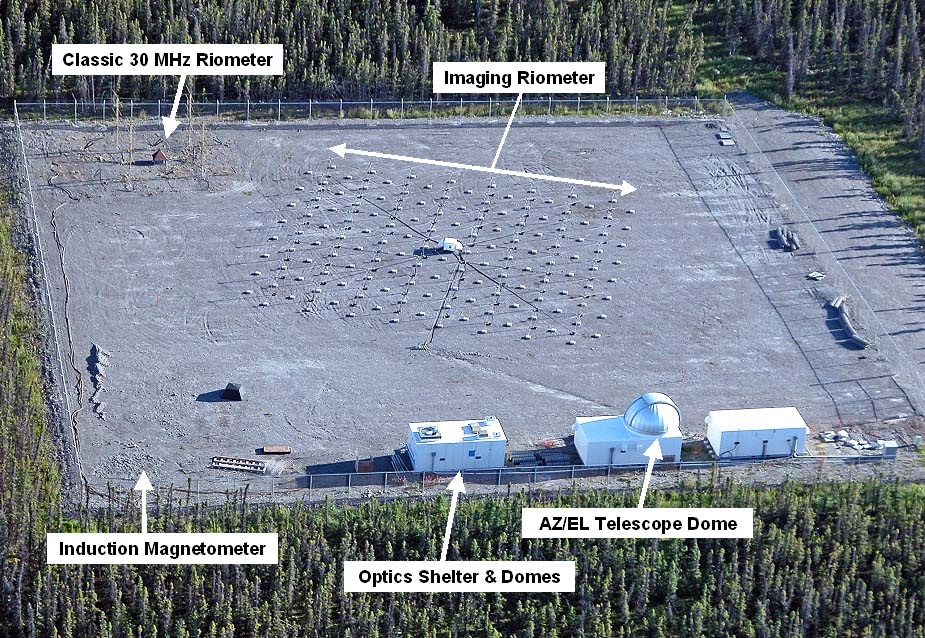Riometer on:
[Wikipedia]
[Google]
[Amazon]


 A riometer (commonly ''r''elative ''i''onospheric ''o''pacity meter, although originally: Relative Ionospheric Opacity Meter for Extra-Terrestrial Emissions of Radio noise) is an instrument used to quantify the amount of electromagnetic-wave
A riometer (commonly ''r''elative ''i''onospheric ''o''pacity meter, although originally: Relative Ionospheric Opacity Meter for Extra-Terrestrial Emissions of Radio noise) is an instrument used to quantify the amount of electromagnetic-wave
List of the world's riometersIRIS riometer
Atmospheric sciences {{Tool-stub


 A riometer (commonly ''r''elative ''i''onospheric ''o''pacity meter, although originally: Relative Ionospheric Opacity Meter for Extra-Terrestrial Emissions of Radio noise) is an instrument used to quantify the amount of electromagnetic-wave
A riometer (commonly ''r''elative ''i''onospheric ''o''pacity meter, although originally: Relative Ionospheric Opacity Meter for Extra-Terrestrial Emissions of Radio noise) is an instrument used to quantify the amount of electromagnetic-wave ionospheric absorption
Ionospheric absorption (or ISAB) is the scientific name for absorption occurring as a result of the interaction between various types of electromagnetic waves and the free electrons in the ionosphere, which can interfere with radio transmissions.
...
in the atmosphere. As the name implies, a riometer measures the "opacity" of the ionosphere to radio noise emanating from cosmic origin. In the absence of any ionospheric absorption, this radio noise, averaged over a sufficiently long period of time, forms a ''quiet-day curve.'' Increased ionization in the ionosphere will cause absorption of radio signals (both terrestrial and extraterrestrial), and a departure from the quiet-day curve. The difference between the quiet-day curve and the riometer signal is an indicator of the amount of absorption, and is measured in decibels
The decibel (symbol: dB) is a relative unit of measurement equal to one tenth of a bel (B). It expresses the ratio of two values of a Power, root-power, and field quantities, power or root-power quantity on a logarithmic scale. Two signals whose ...
. Riometers are generally passive radio antenna
Antenna ( antennas or antennae) may refer to:
Science and engineering
* Antenna (radio), also known as an aerial, a transducer designed to transmit or receive electromagnetic (e.g., TV or radio) waves
* Antennae Galaxies, the name of two collid ...
operating in the VHF
Very high frequency (VHF) is the ITU designation for the range of radio frequency electromagnetic waves (radio waves) from 30 to 300 megahertz (MHz), with corresponding wavelengths of ten meters to one meter.
Frequencies immediately below VHF ...
radio frequency range (~30-40 MHz). Electromagnetic radiation of that frequency is typically Galactic synchrotron radiation
Synchrotron radiation (also known as magnetobremsstrahlung radiation) is the electromagnetic radiation emitted when relativistic charged particles are subject to an acceleration perpendicular to their velocity (). It is produced artificially in ...
and is absorbed in the Earth's D region of the ionosphere.
Description
The riometer was developed in the mid-1950s by scientists at theUniversity of Alaska
The University of Alaska System is a system of public universities in the U.S. state of Alaska. It was created in 1917 and comprises three separately accredited universities on 19 campuses. The system serves nearly 30,000 full- and part-time stud ...
who were researching the radio propagation effects of aurorae
An aurora (plural: auroras or aurorae), also commonly known as the polar lights, is a natural light display in Earth's sky, predominantly seen in polar regions of Earth, high-latitude regions (around the Arctic and Antarctic). Auroras display ...
. At times aurorae resulted in complete failure of long-distance radio communication to planes in the Arctic - a matter of considerable concern to the US Air Force at a time of tension with the Soviet Union. Riometers are still used today for ionospheric research and are typically located in polar and sub-polar areas.
Initially, riometers were single, wide-beam detectors and measured the cosmic noise absorption (CNA). Multi-beam riometers have also been developed, which have multiple narrow beams, typically formed by a Butler matrix A Butler matrix is a beamforming network used to feed a phased array of driven element, antenna elements. Its purpose is to control the direction of a beam, or beams, of radio transmission. It consists of an n \times n matrix (n some power of two) w ...
on a phased antenna array. Each beam forms its own riometer and has its own quiet-day curve determination. These individual beams form pixels
In digital imaging, a pixel (abbreviated px), pel, or picture element is the smallest addressable element in a raster image, or the smallest point in an all points addressable display device.
In most digital display devices, pixels are the sm ...
on the sky allowing simple images of cosmic noise absorption to be formed. More recently, interferometry has been used to provide all-sky, spatially-continuous imaging of CNA. It is also possible to use riometers to observe multiple frequencies (typically in the range 25-40 MHz). An inverse problem technique can be applied to the measurements to ascertain not just the absorption, but a model of the electron content as a function of sight distance.
References
External links
List of the world's riometers
Atmospheric sciences {{Tool-stub